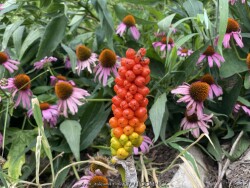
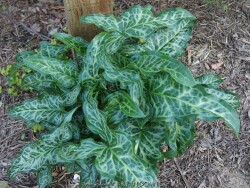
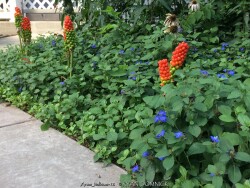

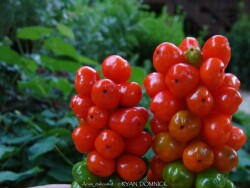
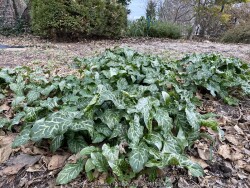
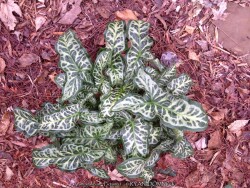

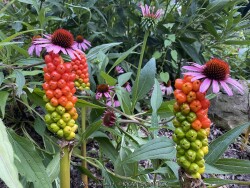
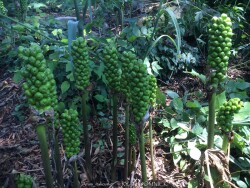
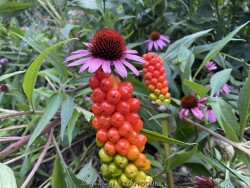
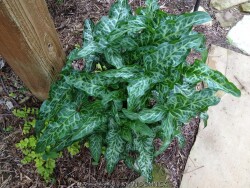
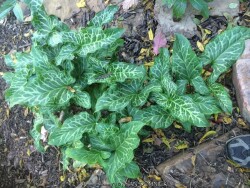
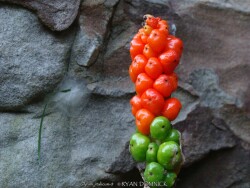
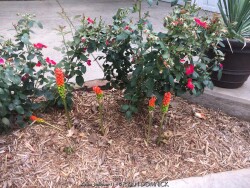
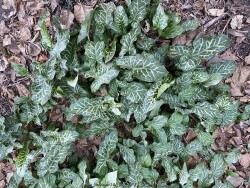
Plant Min Zone: 5a
Plant Max Zone: 9a
Sunlight: Full Sun, Part Sun, Shade
Water / Rainfall: Low, Average, High
Soil Quality: Average, Rich
Bloom Season: Spring
Flower Color: Cream
Berry / Fruit Color: Orangish Red, Orange
Spring Foliage Color: Green, Variegated
Summer Foliage Color: None: Dormant
Fall Foliage Color: Green, Variegated
Evergreen Foliage: Yes
Winter Interest: Yes
Scented Flowers: No
Drought Tolerance: Medium, High
Wet-Feet Tolerance: Medium, High
Humidity Tolerance: Medium, High
Wind Tolerance: Low
Poor Soil Tolerance: Clay Soils
Height: 1' - 1.5'
Width: 1' - 1.5'
Growth Rate: Slow, Medium
Service Life: Very Long: 10-20 years
Maintenance Need: Low
Spreading Potential: Low
Yearly Trimming Tips: Trim Evergreen Perennial Only if Winter-Kill Occurs.
Plant Grouping Size: Specimen Planting of 1-3, Small Grouping of 3-5
Best Side of House: South Exposure, West Exposure, East Exposure, North Exposure
Extreme Planting Locations: Tolerates Damp Full Shade, Base of Retaining Wall Locations, Resistant to Rabbits, Large Tropical Foliage / Flowers
Ornamental Features: Emerges Early in Spring, Long Lasting Fall Color, Bright Winter Color, Large Tropical Foliage / Flowers, Exceptional / Colorful Foliage
Special Landscape Uses: None
Possible Pest Problems: None
Plant Limitations: May be Dormant in Summer, May be Poisonous
Shippable in 2026: YES
Italian Painted Arum (Arum italicum 'Pictum') is native to the Mediterranean region. It has a reversed or off-schedule life cycle; growing when other plants have already shed their leaves to take advantage of sunlight and lack of competition. It is often planted for its unusual evergreen leaf pattern and color resembling a bright green house plant growing outside in winter. Foliage goes dormant by June but is followed by naked stalks emerging from the ground with reddish orange berries. Foliage re-appears in fall and lasts well into winter untouched. If low temperatures hit 0 degrees F, foliage finally dies back to the ground and re-emerges in early spring to repeat the life cycle. If low temperatures hit -15 degrees F, it may kill an un-mulched plant; protect any zone 5/6 perennial with a 2-3" thick layer of mulch. Grow in average to rich well drained garden soil in full sun or full shade with everything in between. Moderate dry shade does not seem to be a problem because arum goes dormant anyways in the heat of summer. This holds true for planting in sunny locations to. Combine with shade garden plants that will fill the space in summer such as hostas or solomon seal. Also great when combined with late-emerging spring perennials (like plumbago, hardy hibiscus, and orange butterfly weed) because it fills that early spring space starting to grow extremely early with freeze-resistant foliage. Then later in the summer when Arum goes dormant, these plants hide the dying foliage and void left in the garden; what a great way for two species to share the same garden space! It has potential to be invasive in parts of the country such as the Pacific Northeast USA but not in Kansas. It is very stable but does not self-seed or spread in Lawrence, KS gardens; bulb offsets develop but only thicken the existing clump over time. Considered to be a great permatanet multi-season perennial for your garden.